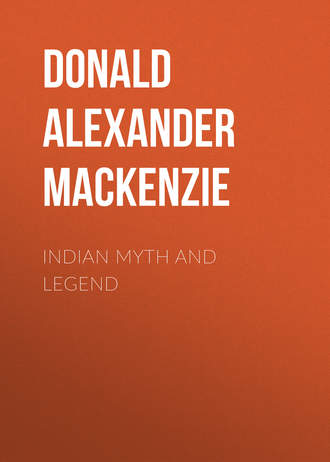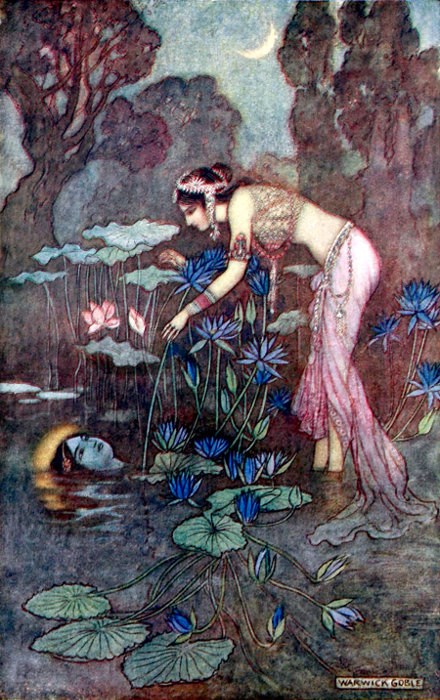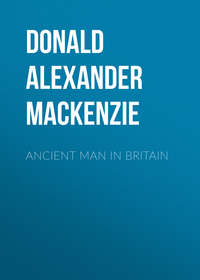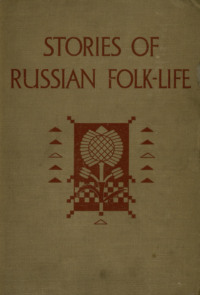 полная версия
полная версияIndian Myth and Legend

Donald A. Mackenzie
Indian Myth and Legend

SITA FINDS RAMA AMONG LOTUS BLOOMS
From the painting by Warwick Goble
PREFACE
This volume deals with the myths and legends of India, which survive to us in the rich and abundant storehouse of Sanskrit literature, and with the rise and growth of Brahmanism, Buddhism, Jainism, &c. The reader is introduced to the various sacred works of the Hindus, including the ancient invocatory hymns of the four Vedas, the later speculative and expository “Forest Books” in which “the Absolute is grasped and proclaimed”, and those great epic poems the Rámáyana, which is three times longer than the Iliad, and the Máhábharata, which is four times longer than the Rámáyana. In no other country have the national poets given fuller and finer expression to the beliefs and ideals and traditions of a people, or achieved as a result wider and more enduring fame. At the present day over two hundred million Hindus are familiar in varying degrees with the legendary themes and traditional beliefs which the ancient forest sages and poets of India invested with much beautiful symbolism, and used as mediums for speculative thought and profound spiritual teachings. The sacred books of India are to the Hindus what the Bible is to Christians. Those who read them, or hear them read, are believed to be assured of prosperity in this world and of salvation in the next. To students of history, of ethnology, and of comparative religion they present features of peculiar interest, for they contain an elaborate sociology of the ancient Aryo-Indians, their political organizations, their codes of laws, their high ethical code, and above all their conceptions of God, the soul, and the Universe. Some knowledge of them is necessary for those who desire to approach with sympathy the investigation of the religious beliefs of our Hindu fellow men and to understand their outlook upon life and the world.
The Introduction deals with various aspects of the study of these ancient myths and legends which have been the inspiration of a national literature infused with much grandeur and sublimity. The historic Aryan controversy, of which the science of comparative mythology is a by-product, is passed under review, and it is shown to what extent philological theories regarding race problems have been modified during recent years as a result of the adoption of broader and more exact methods of ethnic and archæological research and the ever-extending study of comparative mythology. There has also been condensed much important data dealing with the early phases of Aryo-Indian civilization accumulated for historical purposes by industrious and painstaking Sanskrit scholars who have been engaged in investigating and systematizing the internal evidence of the various religious poems and treatises. It will be found that no general agreement has yet been reached regarding Aryo-Indian chronology, but it now appears to be well established that although there were early cultural as well as racial “drifts”, fresh invasions, which had far-reaching results in the social and religious life of northern India, occurred at a late period in what is known as the Vedic Age. In consequence, the problem presented by this ancient civilization tends rather to grow more complex than to become simplified. Its origin is still wrapped in obscurity. At the very dawn of history Aryo-Indian culture had attained a comparatively high state of development, and a considerable period must be allowed for its growth. Even some of the ancient Vedic hymns, addressed by priests to the deities, are styled “new songs”, which suggests the existence of an older collection. Many of them also afford indications that immemorial beliefs were in process of change and fusion. The sublime deities, Varuna and Mitra (Mithra), for instance, were already declining in splendour. Yet they must have been closely associated with Indra, king of the gods, in the unknown Aryan homeland, as is made evident by an inscription recently deciphered at Boghaz Köi, in Asia Minor, which refers to them as deities of the mysterious Mitanni people who were of Aryan speech like the settlers in the Punjab. There is no evidence, however, that the Mitanni rulers gave recognition to the fire god Agni, who in India was exalted as the twin brother of Indra. The problem involved may not be devoid of ethnic significance, although the identity of the Agni-worshipping section of the early raiders remains obscure.
During the early Vedic Age in India prominence was given to the gods: the social organization was of patriarchal character; the goddesses remained shadowy and vague, some being, indeed, little more than figures of speech. A great change took place, however, after the invasions of the Bharata and other tribes who are now referred to as “late comers”. Profound and speculative thinkers attained to the pantheistic conception of the world soul; new doctrines, which are not referred to in the Vedic hymns, regarding the ages of the universe and transmigration of souls, received wide acceptance as the result of missionary efforts: the Vedic gods were reduced to the position of minor deities and new goddesses rose into prominence, one indeed being Bharati, the tribal deity of the Bharatas, who became associated with the Saraswati river and under her new name was ultimately made the wife of the supreme god Brahma. It is significant to note that the new culture radiated from the “Middle Country”, the area controlled by the “late comers”. That it contained elements which were not of Indian origin is made clearly evident when we find that the doctrines of the ages of the universe and transmigration of souls were shared by other peoples, including the Greeks and Celts and a section of the ancient Egyptians. Sumero-Babylonian and Egyptian resemblances may also be traced in post-Vedic religious literature, the former, for instance, in the Deluge legend, and the latter in the myth regarding the avenging goddess Kali, who slaughters the enemies of the gods like Hathor-Sekhet, and has similarly to be restrained by one of the deities. The worship of goddesses was also prominent among the Sumerians, Egyptians, Greeks, and Celts, as contrasted with the worship of gods among broad-headed mountain and wandering peoples. In this connection special interest attaches to the conclusions of prominent ethnologists, who include in the Mediterranean or “Brown” race of brunet “long heads” the early Egyptians and Neolithic Europeans, the Sumerians and present-day “Aryan” types in India, and especially in the old “Middle Country” and Bengal. On the other hand, a broad-headed type is still prominent in the Punjab, the area occupied by the earliest invaders who worshipped the Vedic gods. Dr. Haddon suggests that these pioneers of civilization were mixed with peoples of Mongolian and other affinities. Some such ethnic explanation must be urged to account for the differences between Vedic and post-Vedic mythologies. The invasions of the “late comers”, who entered India by a new route, no doubt stimulated thought and promoted culture after settled conditions were secured, as was undoubtedly the result of the mingling of races elsewhere.
“It may be put down as an axiom”, says Professor Jastrow, “that nowhere does a high form of culture arise without the commingling of diverse ethnic elements. Civilization, like the spark emitted by the striking of steel on flint, is everywhere the result of stimulus evoked by the friction of one ethnic group upon another”: and he supports his theory with the evidence afforded by Egypt, Babylonia, Greece, Rome, France, Germany, and Great Britain, as well as the present-day United States of America, “the melting pot” of many peoples.
Throughout this volume comparative evidence is provided to assist the reader towards the study of this most interesting aspect of the Aryan problem. We trace the cremation custom, which has prevailed in India since Vedic times, to countries as wide apart as Great Britain, into which it was introduced during the Bronze Age, and Southern Siberia, where it is still practised by the Mongolian Buriats. Over the areas occupied by representatives of the Mediterranean race it was unknown prior to the invasions of unidentified fire-worshippers. Special interest also attaches to the horse sacrifice, which was also an Aryo-Indian ceremony even in Vedic times. It is not yet unknown among the Buriats. At one time the horse sacrifice was widely prevalent. White horses were sacrificed to the sun in Ancient Greece; the sun horses are referred to with horror by Ezekiel; the ceremony was also connected with the mysteries of Aricia grove. Indeed, as is pointed out in Chapter V, various ancient peoples offered up this domesticated and historic animal. In the Indian epics and religious treatises there are illuminating references to the horse sacrifice which throw much light on the significance of the immemorial practice. White and black horses were alternately favoured, and it is evident that the practice was not only associated with solar worship, but was also intended to secure fertility—crops, and therefore rain in the first place, increase of flocks, herds, human offspring, &c.—as is undoubtedly the case among the modern-day Buriats. In India the horse was also offered up as a sin offering, a late conception, evidently. A prominent feature of this sacrifice in most countries was the decapitation of the sacrificial victim. Recent evidence from Egypt suggests that the sacrifice of the ass may have preceded the sacrifice of the horse. Professor Flinders Petrie has found in a triple tomb in the early dynastic Tarkhan cemetery the skeletons of three asses with the heads cut off and placed beside them. He suggests that the animals were killed to accompany their owner to the other world. The Buriats still sacrifice horses at graves, professedly for the same reason. As this custom was not prevalent throughout Ancient Egypt, it may have been an importation, connected, perhaps, with the myth about the sun-ass which gallops round a hill-surrounded world followed by the pursuing night serpent. An isolated reference is also made to the sacrifice of the ass in a Twelfth Dynasty story about a Naga-like demigod, a fact which emphasizes the historical importance of the material embedded in folk tales and mythologies. In this connection it may be noted that certain developed myths suggest there may have been either a cultural contact of Ancient Egypt with India, through an unidentified medium, or an infusion of religious ideas into both countries from a common source. In an Indian creation myth Prajápati weeps creative tears like the Egyptian sun-god Ra, whose rays are tears from which all things spring, as Maspero shows.
In India the juice of the soma plant was identified with the vital principle, and the demons were the poisoners of crops and plants; in Egypt honey-flowers and sacred trees sprang from the fertilizing tears of deities, while the tears of demons produced poisonous plants, diseases, &c. Like the Egyptian Horus, the Indian Prajápati, or Brahma, sprang from a lotus bloom floating on the primordial waters. The chaos-egg myth is also common to both mythological systems. Brahma issues from a golden egg like Ra, and a similar myth is connected with the Egyptian Ptah and Khnumu, and with the Chinese P'an Ku, while the egg figures in Eur-Asian folk tales which contain the germs of the various mythologies. All mythologies have animistic bases; they were, to begin with, systematized folk beliefs which were carried hither and thither in various stages of development by migrating and trading peoples. Each separate system bears undoubted traces of racial or local influences; each reflects the civilization in which it flourished, the habits of thought and habits of life of the people, and the religious, ethical, and political ideals of their rulers and teachers. When well-developed myths of similar character are found in widely separated districts, an ethnic or cultural contact is suggested. Such myths may be regarded as evidence of remote racial movements, which, although unsupported by record or tradition, are also indicated by ethnological data. It is hoped that the reader will find much suggestive material in this connection in their study of the myths and legends of India. They will also find that many of the tales retold in this volume have qualities which make universal appeal, and that some are among the most beautiful which survive from the civilizations of the ancient world.
Not a few, we are assured, will follow with interest the development from primitive myths of great and ennobling ideas which have exercised a culturing influence in India through many long centuries, and are still potent factors in the domestic, social, and religious life of many millions of Hindus.
DONALD A. MACKENZIE.To My Indian Friends
INTRODUCTION
The triangular sub-continent of India is cut off from the rest of Asia by the vast barriers of the Himalayas, the Hindu Kush, the Suleiman mountains, and the Indian Ocean. Its population comprises about two hundred and ninety-five millions, and is of greatest density on the fertile northern plain, which is watered by three river systems, the Indus and its tributaries on the west, and the Ganges and Brahmaputra with their tributaries which pour into the Bay of Bengal. South of the Vindhya mountain ranges is the plateau of the Deccan. The climate varies from temperate on the Himalayan slopes to tropical in southern India, and over the entire country there are two pronounced annual seasons, the dry and the rainy.
Our interest abides in this volume chiefly with the northern plain and the people who are familiar in varying degrees with the sacred and heroic literature passed under review; that is, with the scenes of the early Indian civilization known as Aryan and those numerous inheritors of Aryan traditions, the Hindus, who exceed two hundred and seven millions of the population of India. Modern Hinduism embraces a number of cults which are connected with the early religious doctrines of the Aryanized or Brahmanized India of the past; it recognizes, among other things, the ancient caste system which includes distinct racial types varying from what is known as the Aryan to the pre-Dravidian stocks. Other religious organizations may be referred to in passing. Buddhists are chiefly confined to Burma, Sikhs number two millions, the Mohammedans nearly sixty-three millions, while the Parsees number roughly ninety-five thousand; less than three million natives and half-castes are Christians.
Like Egypt, India is a land of ancient memories, but its history, or rather pre-history, does not begin until about a thousand years after the erection was completed of the great pyramids at Gizeh. Between 2000 B.C. and 1200 B.C. tribes of pastoral and patriarchal peoples of Aryan speech were pouring over the north-western frontier and settling in the Punjab. There are no written or inscribed records, or even native traditions, of this historic migration, but we are able to follow vaguely, from the references found in religious compositions, the gradual conquest of northern India, which covered a period of several centuries. To what extent this invasion was racial, rather than cultural, it is extremely difficult to discover. But no doubt can be entertained regarding the influence exercised by the ancient military aristocracy and their religious teachers. Certain of the Aryan gods still receive recognition in India after a lapse of over three thousand years. This fact makes Indian mythology of special interest to the ever-increasing number of students of comparative religion.
Indian mythology also possesses particular attractions for us on account of its intimate association with what is known as the “Aryan problem”. Scholars of a past generation held pronounced views on Aryan matters, and produced a considerable literature of highly controversial character. In fact, theories regarding the Aryan languages and the Aryan “race” are as varied as they are numerous; the wordy warfare which occupied the greater part of the nineteenth century, was waged ever strenuously and not infrequently with much brilliance; occasionally, however, it was not awanting in the undesirable elements of personal feeling and national antipathy. But, happily, we appear to have reached a time when this fascinating and important problem can be considered dispassionately in the proper scientific spirit, and without experiencing that unnecessary dread of having to abandon decided opinions which may have been formed when the accumulated data had less variety and bulk than that which is now available. This change has been brought about by the extended study of comparative religion and the wonderful and engaging results which have attended modern-day methods of ethnic and archæological research.
The Aryan controversy had its origin at the close of the eighteenth century, when that distinguished Oriental scholar Sir William Jones, who acted for a period as a judge of the Supreme Court in Bengal, drew attention to the remarkable resemblances between the Sanskrit, Greek, Latin, German, and Celtic languages. In 1808, Schlegel published his Language and Wisdom of the Hindus, and urged the theory that India was the home of an ancestral race and a group of languages that were progenitors of various European ones. Other scholars subsequently favoured Zend, the language of Persia, and transferred the “racial beehive” to that country; rival claims were afterwards set up for Asia Minor and the Iranian plateau.
The science of Comparative Philology was a direct product of these early controversies; it was established in the “thirties” when Bopp published his Comparative Grammar in which a new term, having a racial significance, was invented: he grouped all European languages, except Basque, Magyar, Turkish, and Finnish, as “Indo-Germanic”. After the study of Sanskrit literature revealed, however, that the Aryans occupied but a small part of India when their sacred hymns, the Vedas, were composed, the cradle of the Aryan race was shifted to some uncertain area beyond the Himalayan mountains.
Max Müller, the distinguished Sanskrit authority, who in the words of an Indian scholar “devoted his lifetime to the elucidation of the learning, literature, and religion of ancient India”,1 abandoned Bopp's patriotic term “Indo-Germanic” and adopted Aryan, which he founded on the Sanskrit racial designation “Arya”. At first he accepted the theory of an Aryan race and especially of an Aryan civilization which originated on the Central Asian plateau, but, as will be seen, he subsequently modified his views in this regard.
A new theory regarding the Aryans, who are now more commonly referred to as Indo-Europeans, was strongly advocated in 1851 and later by Dr. Robert Gordon Latham, who devoted many years to the study of ethnology and philology. He argued that as the major part of the peoples speaking Indo-European tongues was found in Europe, the cradle of the race might, after all, be transferred westward. This theory was supported by the fact (among others) that the Lithuanian language was no less archaic than Sanskrit.
The European hypothesis found in time many able supporters, and the advocates of rival Teutonic and Celtic claims waxed eloquent and heated over the exact location of the Aryan homeland. An industrious search was meanwhile conducted for words common to all Aryan languages which described the natural features of the racial “cradle”. This work of reconstruction was certainly not lacking in picturesque results, for attractive visions were presented of Aryan Arcadias in which the simple and contemplative ancestors of many bitter controversialists dwelt together in exemplary unity and peace. The question of location might remain unsettled, but it was generally agreed that the ancient people were surrounded by cows, sheep, and goats; sometimes they rode their horses or yoked them in rough rumbling carts, and sometimes they ate them. No asses were admitted to the fold because of their decided partiality for Central Asian plains, which seemed quite reasonable. Trouble was occasionally caused by wolves and bears, or, mayhap, a stray lion, but these and other worries associated with the simple life might be compensated for by the fact that the primitive people, as one writer2 put it, “understood the art of drinking”. Mead, brewed from honey, was found to be “dear to the hearts of the ancient Aryans”; had the Brahman ever forgotten his “madhu”, the Welshman his “medhu”, or the Lithuanian his “medus”? Problems arose regarding the ancients' knowledge of trees: it was found that “bhaga” was applied indifferently by the family groups to the beech and the oak, and more than one ingenious explanation was suggested to account for this apparent discrepancy. Then, suddenly, Professor Max Müller swept into the background the rival Aryan homeland pictures, pointing out the while that it is “almost impossible to discover any animal or any plant that is peculiar to the north of Europe and is not found sporadically in Asia also”. Destructive criticism proceeded apace, until now nothing has been left to us of the ancestral Arcadia but “air, water, heat and cold”. In his review of the widely accepted philological “evidence” regarding the Aryan homeland, Max Müller declared it to be so pliant that it was possible “to make out a more or less plausible case for any part of the world”. The advanced group of philologists held, indeed, that no racial centre could be located. Ultimately “Delbrück went so far,” says Professor Ripley, “as to deny that any single parent language ever existed in fact”.3
Meanwhile ethnologists and archæologists were engaged accumulating important data. It was found that Europe had been invaded at the close of the Stone Age by a broad-headed (brachycephalic) people, who brought no culture and even retarded the growth of civilization in their areas of settlement. A new problem was thus presented: were the Aryans a brachycephalic (broad-headed) or a dolichocephalic (long-headed) people? Its solution was rendered all the more difficult when it was found that living representatives of both racial types were peoples of Aryan speech. The idea that skull shapes, which are associated with other distinct physical characteristics, were due to habits of life and the quality of food which had to be masticated, was in time advanced to discredit new methods of ethnic research, but it has since been thoroughly disproved. In many ancient graves are found skulls which do not differ from those of modern men and women, living under different conditions and eating different food.
Patriotic controversialists were not awanting again in dealing with the problem of varying skull shapes. French scientists, for instance, have identified the “broad heads”, now generally known as the Alpine race, with the ubiquitous Celts, but as present-day Hindus are mainly “long heads”, the Aryan racial connection here suggested remains obscure. A clue to the mystery was sought for in Asia Minor, but no satisfactory result could be obtained there to support philological theories, because the Armenians, who are “broad heads”, and their enemies and neighbours the Kurds, who are “long heads”, are both peoples of Aryan speech. A scornful scientist has dismissed as a “prehistoric romance”, the theory that the fair Scandinavian “long heads” are identical with the brunet “long heads” of India. Both the Celtic (Alpine) and Indo-Germanic racial theories are as inconclusive as they are diametrically in opposition.
The science of philology, which, at its inception, “dazzled and silenced all”, has been proved to be no safe guide in racial matters. We must avoid, as Professor Ripley says, “the error of confusing community of language with identity of race. Nationality may often follow linguistic boundaries, but race bears no necessary relation whatever to them.”4
By way of illustration, it may be pointed out in this connection that English is spoken at the present day by, among others, the Hong Kong Chinamen, the American Red Indians and negroes, by the natives of Ireland, Wales, Cornwall, and the Scottish Highlands, besides the descendants of the ancient Britons, the Jutes, the Angles, the Saxons, the Norsemen, the Danes, and the Normans in England, but all these peoples cannot be classified in the racial sense simply as Englishmen. Similarly, the varied types of humanity who are Aryan in speech cannot all be regarded as representatives of the “Aryan race”, that is, if we accept the theory of an “Aryan race”, which Virchow, by the way, has characterized as “a pure fiction”.






